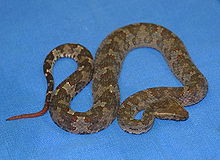- Ovophis okinavensis
-
Ovophis okinavensis 
Scientific classification Kingdom: Animalia Phylum: Chordata Subphylum: Vertebrata Class: Reptilia Order: Squamata Suborder: Serpentes Family: Viperidae Subfamily: Crotalinae Genus: Ovophis Species: O. okinavensis Binomial name Ovophis okinavensis
(Boulenger, 1892)Synonyms - Trimeresurus okinavensis - Boulenger, 1892
- Lachesis okinavensis - Boulenger, 1896
- Ovophis okinavensis - Burger, 1981[1]
Ovophis okinavensis is a venomous pitviper species found in the Ryukyu Islands of Japan. No subspecies are currently recognized.[5]
Contents
Description
This is the longest Asian pitviper, adults are usually 1.1-1.7 m long (max. 3.0 m). Body usually pale greenish-brown, or yellowish-olive (sometimes pale brown), w/ alternating, darker brownish or greenish dorsal blotches, each bordered w/ yellowish scales. Head large, triangular, distinct from neck, narrow dark postocular stripe. .[4]
Scalation includes 23 or 21 rows of dorsal scales at midbody, 125-135 ventral scales, 36-55 paired subcaudal scales and 8 (sometimes 7 or 9) supralabial scales.[2]
The color pattern consists of a gray ground color overlaid with a series of dark gray of grayish-black crossbands. A ventrolateral pattern of black spots against a gray-white background is also present.[4]
Geographic range
Found in the Ryukyu Islands of Japan, including Okinawa and the Amami Islands. The type locality given is "Okinawa."[1]
Habitat
Occurs in various of habitat, including open woodland, forests, mountains, fields, in farming areas with nearby streams, ponds and other water sources. It can also be found in human habitations[4]
Feeding
Hunts for rodents and other vertebrates in open area, especially in sugar cane fields and, sometimes near human habitations.[4][6]
Reproduction
Both oviparous and ovoviviparous. Depending on environmental condition, females will either deposit their eggs, or retain them to incubate internally and give birth later to live young.[4]
Venom
Like most vipers, the Ovophis okinavensis's venom is mainly hemotoxin with potent Cytotoxicity factors. This species causes the most serious snakebite in Japan. People are bitten when they step on this sluggish snake at night, or tending crops by day.
See also
- List of crotaline species and subspecies
- Crotalinae by common name
- Crotalinae by taxonomic synonyms
- Snakebite
References
- ^ a b McDiarmid RW, Campbell JA, Touré T. 1999. Snake Species of the World: A Taxonomic and Geographic Reference, vol. 1. Herpetologists' League. 511 pp. ISBN 1-893777-00-6 (series). ISBN 1-893777-01-4 (volume).
- ^ a b Gumprecht A, Tillack F, Orlov NL, Captain A, Ryabov S. 2004. Asian Pitvipers. GeitjeBooks Berlin. 1st Edition. 368 pp. ISBN 3-937975-00-4.
- ^ Brown JH. 1973. Toxicology and Pharmacology of Venoms from Poisonous Snakes. Springfield, Illinois: Charles C. Thomas. 184 pp. LCCCN 73-229. ISBN 0-398-02808-7.
- ^ a b c d e f Mehrtens JM. 1987. Living Snakes of the World in Color. New York: Sterling Publishers. 480 pp. ISBN 0-8069-6460-X.
- ^ "Ovophis okinavensis". Integrated Taxonomic Information System. http://www.itis.gov/servlet/SingleRpt/SingleRpt?search_topic=TSN&search_value=634900. Retrieved 25 July 2008.
- ^ http://www.afpmb.org/pubs/living_hazards/snakes.html#Protobothropsflavoviridis
External links
- Ovophis okinavensis at the Reptarium.cz Reptile Database. Accessed 25 July 2008.
This Alethinophidia article is a stub. You can help Wikipedia by expanding it.
